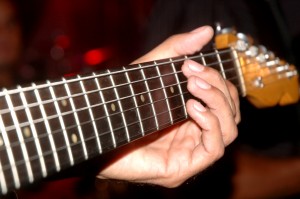
Flamenco is a dance that originated in the south of Spain in the region of Andalucía in the 18th-century. This area of Spain has been heavily influenced by Arabic culture as Arab people were in power here from 711 until 1492. Flamenco also has roots in the gitano or Roma (gypsy) culture.
Traditional flamenco comes in two varieties: jondo, which invokes a type of mournful and soulful singing and carries deep emotional meaning, and a more lighthearted version, alegría, which means happiness in Spanish. Nowadays there are dozens of newer versions of flamenco as artists around the world experiment with this art form. One thing remains constant however, the rhythms are very complex and take a long time to master.
There are three parts to Flamenco: the guitarist, the singer and the dancer(s). Both males and females can take any part but one most commonly sees male singers and guitarists with female dancers. Generally a performance is broken up into sets with the dancers taking turns dancing alone, in pairs or small groups. Dancers use numerous props to accentuate their movements including their dresses, shawls, castanets and colorful fans called abanicos as well as special high-heeled flamenco shoes that make the distinctive tapping sound on the wooden stage.
Flamenco continues to be very popular in Spain, especially in the city of Seville. Since 1980 a bi-annual month-long festival by the name of Bienal de flamenco has been held there in the month of September in even numbered years. It features numerous performances of both traditional and modern takes on flamenco. Another way to catch live flamenco in Spain is by visiting tablaos. These flamenco bars are open late into the night and serve local specialties such as sangría, an alcoholic beverage made of wine, citrus fruits, rum and carbonated water. Also on offer are Spanish appetizers called tapas. These are commonly made with shrimp, octopus, and chorizo, a spicy Spanish sausage.
If you are heading to Seville on holiday here is a website for information on seeing live shows. Luckily you do not have to fly all the way to Seville to see flamenco as we have a great venue right here in Vancouver. Grab some friends and head down to Kino Café in the Cambie Village showcasing live flamenco Wednesday through Sunday nights.







